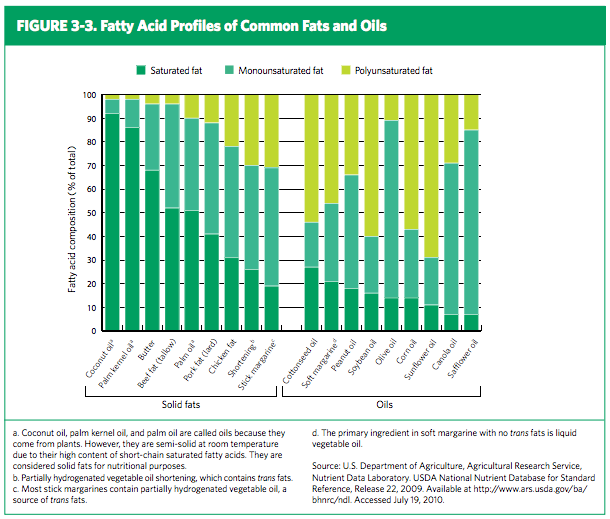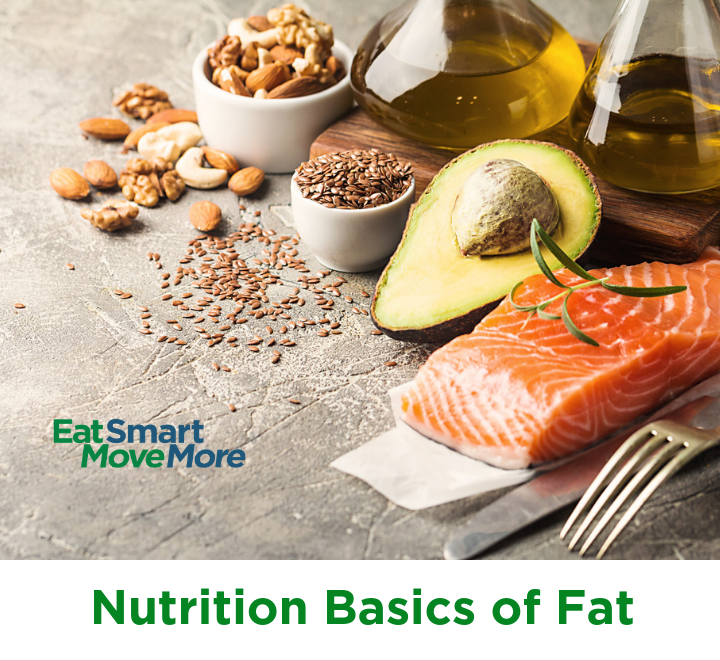In our previous post about the 6 Basic Nutrients, we gave a short description of the macronutrient fat. Today, we’ll go into more detail about the different types of fat, the functions of fat in the body, sources of fat in our diets, and some information about different diets that focus on fat intake.
Fat Recommendations
The Dietary Guidelines for Americans recommend that we aim for 20-35% of calories from fat and to limit saturated fat to less than 10% of calories. For the standard 2,000 calorie diet, this comes out to 44-77 grams of fat per day with less than 22 grams from saturated fat.
MyPlate has several recommendations for making smart choices about dietary fat.
- Go lean with protein. Choose lean varieties of meat. Trim or drain fat from meat and remove poultry skin.
- Eat more plant-based protein, like beans, nuts, and seeds, to reduce saturated fat. Nuts and seeds are high-calorie foods, so eat small portions to keep calories lower.
- Choose seafood rich in omega-3 fatty acids, such as salmon, trout, and herring, at least twice a week.
- Move to low-fat (1%) or fat-free (skim) milk or yogurt. If you usually drink whole milk or eat full fat yogurt, switch gradually to reduced fat (2%), then low-fat (1%), and finally fat-free (skim). Choose milk and yogurt more often than cheese, which is higher in fat and calories.
Types of Fat
Fats are found in many different foods, from cooking oils and butter or lard, to animal proteins and seafood, nuts, seeds, and certain fruits (avocados, olives, coconuts, or palm fruits). Most foods contain a mixture of fats, not just a single type. Some are higher in beneficial unsaturated fats and some are predominately less healthy saturated fats.
- Unsaturated Fat – Unsaturated fat is generally liquid at room temperature and is a healthier type of fat for our bodies. Replacing saturated fats with unsaturated fats can reduce the risk of heart disease.
- Essential Polyunsaturated Fats – Omega-6 and Omega-3 fats are special types of unsaturated fats that are essential for our diets, meaning we must get them from food and they are required for good health. Seafood (especially salmon, tuna, mackerel, and sardines) is the best source of omega-3 fatty acids. The Dietary Guidelines recommend 2 servings of seafood each week in order to get enough omega-3s. Other foods with omega-3 fats are walnuts, flaxseed (either oil or ground), and canola oil.
- Saturated Fat – Saturated fat is generally solid at room temperature and is less healthy for our hearts. Saturated fats can raise your blood cholesterol levels, which increases the risk of heart disease.
- Cholesterol – Cholesterol is a waxy substance found in animal products, such as meat, eggs, dairy, or shellfish. Cholesterol is used in our bodies in cell membranes, the outer covering of every cell in our bodies. Our blood circulates cholesterol, too. LDL (aka bad) cholesterol is harmful to our arteries while HDL (aka good) cholesterol helps remove cholesterol from the body. You can read more about cholesterol here.
- Trans Fats – These are unsaturated fats that have been chemically altered to become more saturated. They are listed in the ingredient list as “partially hydrogenated” oils. Trans fats are very damaging to blood vessels and heart health and should be avoided. The Food and Drug Administration has worked to remove these types of fats from the food supply and much fewer products contain them today. It’s still a good idea to check the ingredient list of your grocery items to avoid purchasing items that contain trans fats, such as some types of baked snacks, margarine, shortening, non-dairy coffee creamers, refrigerated biscuit dough, or microwave popcorn.

Function of Fat in Our Bodies
- Concentrated source of calories – Fat contains 9 calories per gram, twice as much as carbohydrates and protein (4 calories per gram). Because of its caloric density and slower digestion, fat helps you feel fuller longer.
- Building block of cells – Fat and cholesterol are used in different cell structures throughout the body. Your brain and nervous system cells contain large portions of fat. Because of their fat content, fat is necessary for proper growth and development of the brain, eyes, and skin.
- Component of hormones – Fats and cholesterol are used to form certain hormones in your body that affect blood pressure, immune system function, and blood clotting. The essential fats Omega-3 and Omega-6 play a large role in these hormone functions.
- Fat-soluble vitamin metabolism – Fat is necessary to absorb and transport fat-soluble vitamins in the body.
Fad Fat Diets
The Ketogenic Diet has been trending recently and is very similar to the Adkins diet of the 90’s. It is VERY high in fat, as much as 70-80% of calories from fat, and low in carbohydrates with moderate or low protein. The diet is designed to shift the body’s fuel source from carbohydrates and blood glucose to a special fuel called “ketones” that are produced when the body burns fat for fuel. This diet has been used to treat epilepsy under close medical supervision and many people are trying the keto diet to lose weight.
When you look at the recommendations and strategies for eating keto, you’ll notice that it does not match MyPlate. It’s MUCH higher in fat than the Dietary Guidelines recommend and very easy to go over the saturated fat limit. Because carbohydrates are restricted, it’s difficult to eat enough whole grains, fruits, and vegetables that are good for your health. Because you’re not getting a good balance of the different food groups, the keto diet is too low in fiber, vitamins, and minerals, too. And the process of shifting your body from carbs to fat is rough. Many people report feeling tired, weak, shakey, headaches, nausea, and constipation, which has been called the “keto flu.” Finally, the keto diet is incredibly restrictive and can be hard to follow long-term.
Coconut oil is another hot topic in nutrition these days. Despite its increasing popularity as a cooking oil or dietary supplement, coconut oil is a highly saturated fat (see graph of the types of fat in different foods), with even more saturated fat than butter. Usually, oils from plants are unsaturated, but coconut oil, palm oil and cocoa butter are all high in saturated fats. 1 tablespoon of coconut oil has 12 grams of saturated fat, more than half the recommended daily amount in just this one food. Not only is coconut oil not that great for our health, it’s also more expensive than other oil options. When you look at all of these facts (high in saturated fat, more expensive), buying and using coconut oil just isn’t a great idea.

Fat is one of the three major sources of energy in our diets. It can make food taste good and help us feel full. Fat has important functions in the body from the structure of cells, to hormone activity and metabolism of fat-soluble vitamins. Despite the popularity of keto diets and coconut oil, the Dietary Guidelines recommend a balanced approach to fat intake and limiting saturated fats to protect your heart. What other questions do you have about fat or cholesterol?

